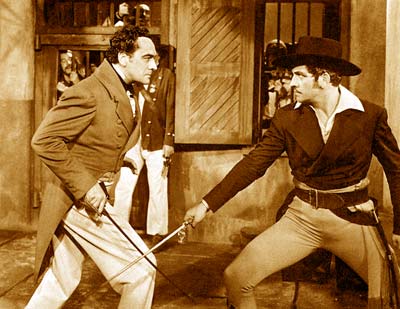
Often when people talk about pirates, they'll use the following words
interchangeably:
Privateer,
Corsair,
Buccaneer, and
Pirate. But in truth, they refer to different things. This primer should help clear up misconceptions.
Pirate: /ˈpaɪ rət/ Pronunciation Key - Show Spelled Pronunciation[pahy-ruh
rət/ Pronunciation Key - Show Spelled Pronunciation[pahy-ruh t]
t] noun
| 1. | a person who robs or commits illegal violence at sea or on the shores of the sea. |
| 2. | a ship used by such persons. |
| 3. | any plunderer, predator, etc.: confidence men, slumlords, and other pirates. |
| 4. | a person who uses or reproduces the work or invention of another without authorization. |
| 5. | Also called pirate stream. Geology. a stream that diverts into its own flow the headwaters of another stream, river, etc. |
Pirate basically is the vague term that refers to all these sea-criminals. It's hard to
mis-use, and applies to all sorts of people and activities.
 Privateer: /ˌpraɪ
Privateer: /ˌpraɪ vəˈtɪər/ Pronunciation Key - Show Spelled Pronunciation[prahy-vuh-teer] noun
vəˈtɪər/ Pronunciation Key - Show Spelled Pronunciation[prahy-vuh-teer] noun
1. an armed ship that is privately owned and manned, commissioned by a government to fight or harass enemy ships.
All privateers are pirates, but not all pirates are privateers. Privateers carry letters of marque from a government, basically a get out of jail free card that can be cashed at their ports when that pirate raids ships belonging to their enemies. Many pirates collected several different country's letters of marque, but one man's legitimate businessman or patriotic hero, is another man's pirate and rogue, and when one's
allegiances are constantly changing its a recipe for trouble. But on the high seas, trouble is a pirate's middle name.
 Buccaneer: /ˌbʌk
Buccaneer: /ˌbʌk əˈnɪər/ Pronunciation Key - Show Spelled Pronunciation[buhk-uh-neer]
əˈnɪər/ Pronunciation Key - Show Spelled Pronunciation[buhk-uh-neer]
1.any of the piratical adventurers who raided Spanish colonies and ships along the American coast in the second half of the 17
th century.
When most people think of pirates, they're thinking of buccaneers. Pirates of the Caribbean who raided the Spanish Main, who elected their captains and made names for themselves in the new world. The romantic image of piracy grew out of these rogues, fiercely democratic, often cruel, swashbuckling and prone to burying treasure (
ok, prone to spending treasure as soon as they could get to a port). Buccaneers are also called Freebooters, from the dutch term for the pirates that operated in the Caribbean during the period.
The word Buccaneer comes from the french
boucanier, which
referred to men who hunted and smoked meat alone in the wilderness. These men were common on
Hispaniola and other islands where they were often picked up by ships, and traded their wares and fearsome skills at butchery.
 Corsair: [kawr-sair] noun
Corsair: [kawr-sair] noun
| 1. | a fast ship used for piracy. |
| 2. | a pirate, esp. formerly of the Barbary Coast. |
Corsairs, also
referred to as Barbary Corsairs came from North Africa and ranged as far afield as India and Ireland. They were subject to the sultanates of their home ports but often had a say in their own governance, even before Europe was toying with democracy.
Check out this Bicameral Legislature. They often took slaves as part of their crews, but slaves got six months of the year off and often converted to Islam and rose to own their own ships. Upward mobility of this sort was unheard of in Europe and a huge number of single men without other prospects emigrated from Europe to convert to Islam and seek their fortunes.

 Dysentery:
Dysentery: Often when people talk about pirates, they'll use the following words interchangeably: Privateer, Corsair, Buccaneer, and Pirate. But in truth, they refer to different things. This primer should help clear up misconceptions.
Often when people talk about pirates, they'll use the following words interchangeably: Privateer, Corsair, Buccaneer, and Pirate. But in truth, they refer to different things. This primer should help clear up misconceptions. rət/ Pronunciation Key - Show Spelled Pronunciation[pahy-ruh
rət/ Pronunciation Key - Show Spelled Pronunciation[pahy-ruh t] noun
t] noun Privateer: /ˌpraɪ
Privateer: /ˌpraɪ vəˈtɪər/ Pronunciation Key - Show Spelled Pronunciation[prahy-vuh-teer] noun
vəˈtɪər/ Pronunciation Key - Show Spelled Pronunciation[prahy-vuh-teer] noun Buccaneer: /ˌbʌk
Buccaneer: /ˌbʌk əˈnɪər/ Pronunciation Key - Show Spelled Pronunciation[buhk-uh-neer]
əˈnɪər/ Pronunciation Key - Show Spelled Pronunciation[buhk-uh-neer] Corsair: [kawr-sair] noun
Corsair: [kawr-sair] noun Show me a person that hates dolphins and I'll show you a person with no heart. People love dolphins because they're so much like humans, but we're jerks and so are they. Let's dive right in to:
Show me a person that hates dolphins and I'll show you a person with no heart. People love dolphins because they're so much like humans, but we're jerks and so are they. Let's dive right in to: Black Bart was a Welsh Pirate who harried the coasts of the Caribbean and West Africa. Originally named John Roberts he changed his name to sound more piratey. After several years of honest merchanting aboard slave ships he turned pirate for fun and profit.
Black Bart was a Welsh Pirate who harried the coasts of the Caribbean and West Africa. Originally named John Roberts he changed his name to sound more piratey. After several years of honest merchanting aboard slave ships he turned pirate for fun and profit.
 This week one has to give due respect to Canada, which not only has a Navy, but one in the Gulf of Aden that
This week one has to give due respect to Canada, which not only has a Navy, but one in the Gulf of Aden that  actually intervened in a pirate attack successfully. See here and here.
actually intervened in a pirate attack successfully. See here and here.
 Dolphins! So winsome and likeable, also, such jerks. Last time we covered the lascivious malignancy of these beloved creatures. And while I love the horny sacks of blubber, the juicy details of their transgressions are too good to keep out of the blog. This time we're going further into the seedy underbelly of Dolphin life with....
Dolphins! So winsome and likeable, also, such jerks. Last time we covered the lascivious malignancy of these beloved creatures. And while I love the horny sacks of blubber, the juicy details of their transgressions are too good to keep out of the blog. This time we're going further into the seedy underbelly of Dolphin life with....
